In Damascus, things are rarely what they seem.
You might be walking through a quiet, sun-dappled alleyway, the air scented with jasmine and cardamom, when you pass a small, worn wooden door—nothing fancy, nothing loud. But if you were lucky enough to step inside, you’d find yourself in another world. A hidden courtyard bursts into view, alive with birdsong, fountains, marble tiles, and the cool shade of citrus trees. It feels like you’ve stumbled into paradise.
This is the secret of Damascus.
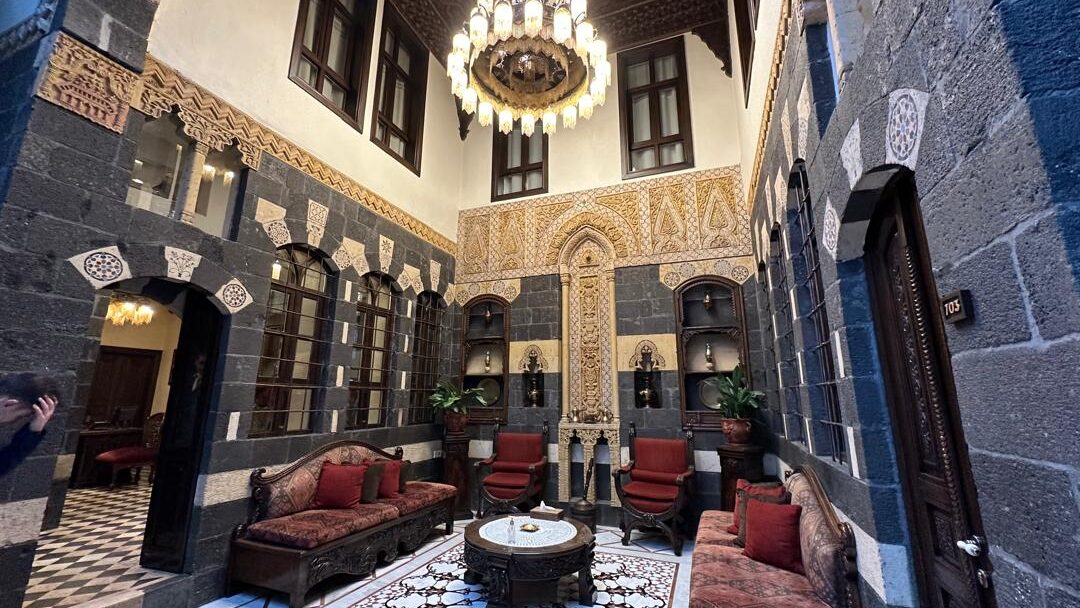
For centuries, Damascenes have kept their most precious beauty tucked away behind closed doors—not because they didn’t want to share it, but because they believed in the “evil eye.” To protect their private heavens from envy, they kept their facades plain and modest, while inside, they built true architectural poetry.
And this concept isn’t just charming—it’s ancient.
Archaeologists found a 5,000-year-old clay model in Mari (an ancient city near the Euphrates) that shows a design almost identical to the Damascene house: a central open-air courtyard surrounded by rooms. That’s how deep this tradition runs—older than the pyramids!
What Makes a Damascene Palace So Special?
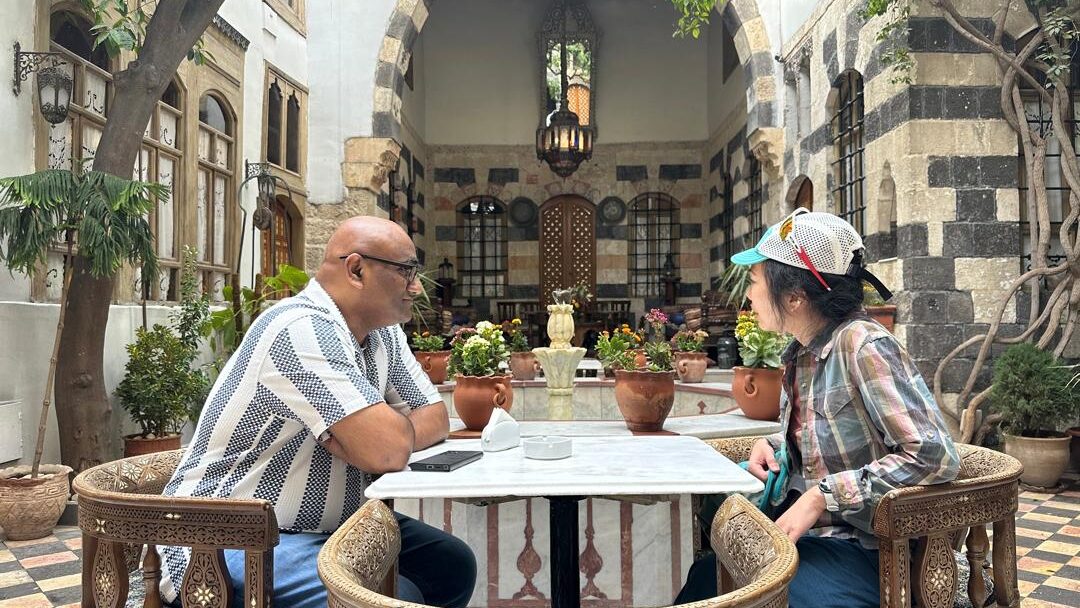
The Damascene house flips the idea of a typical home inside out. In most parts of the world, the garden is outside. But here in Damascus, the garden is hidden inside, tucked within the heart of the house. Why? For privacy, beauty, and peace of mind. It’s like placing the soul of the house at its center.
And it’s not just gardens—everything inside is crafted for comfort and harmony. There’s the “iwan,” a semi-open sitting room always facing south to catch just the right amount of sun. The walls and floors are decorated with marble in ablaq style—a striped pattern using alternating colors of stone. This visual rhythm isn’t just Damascene, it actually traveled across the sea with the Arabs to Spain in the 8th century, influencing Moorish architecture in cities like Córdoba and Granada.
The courtyards are often filled with citrus trees—especially bitter orange, citron, and “naranj.” Damascenes believed these trees helped calm the mind and cool the body. The shape and curve of the leaves soften stress on the brain, encouraging rest, and the foliage itself helps break up sound waves, making the courtyard surprisingly quiet even in the middle of a bustling city.
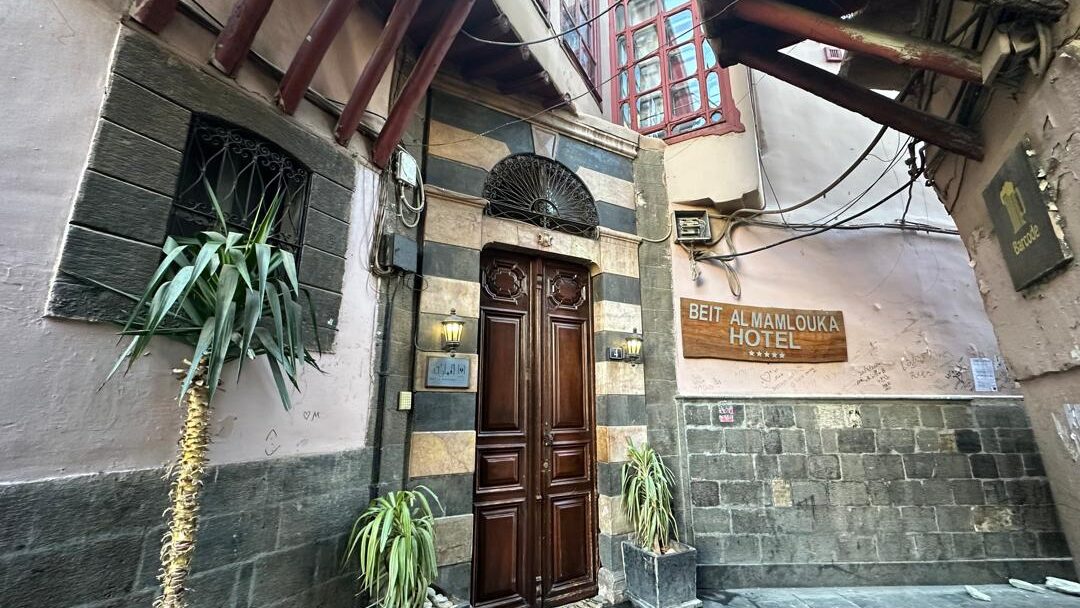
One of the most fascinating rooms in any traditional Damascene home is the “beit el mouneh”—a cool underground storage area where families would stockpile food before refrigerators existed. It stayed so cold that people even stored blocks of ice there during the summer.
From the outside, these homes look unremarkable—no eye-catching décor, no grand balconies, no loud colors. But that’s the point. The beauty is inward, reflective, private. Like the soul of Damascus itself. So when you walk through Damascus today, don’t be fooled by the plain door in front of you. Behind it, you might just find a slice of Eden, a whisper of 5,000 years of civilization, and a story that connects humanity across centuries.
Let’s step through 10 of these magical doors together and discover the palaces that make Old Damascus one of the most enchanting places on Earth.
Beit Farhi – A Historic Jewish Mansion in Old Damascus
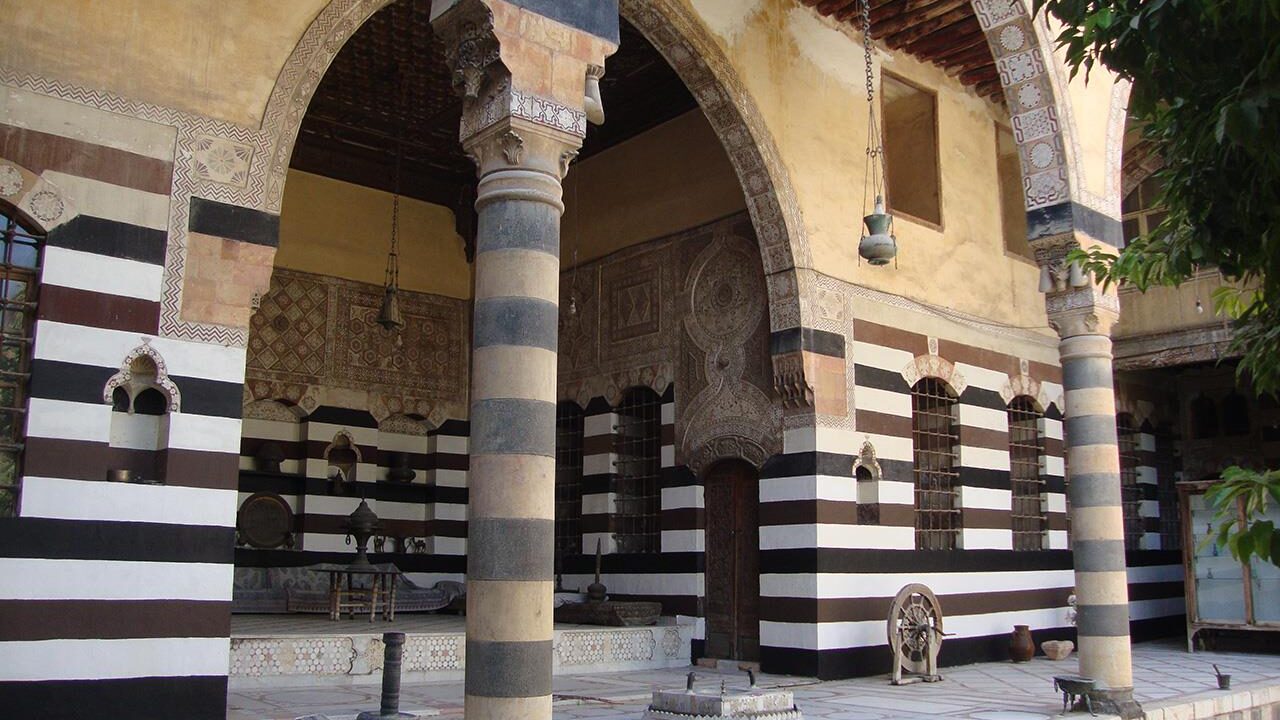
Beit Farhi is an 18th-century Jewish house located in the Jewish Quarter of Old Damascus. It belonged to the Farhi family, one of the wealthiest and most influential Jewish families in the Ottoman Empire. The house is a rare and important example of Jewish heritage in Syria. The building follows traditional Damascene architecture: a modest exterior hides a large interior courtyard with a marble fountain, citrus trees, and rooms decorated with detailed woodwork and painted ceilings. One room features Hebrew inscriptions and likely served as a private synagogue. Beit Farhi is significant because it reflects the multicultural history of Damascus and the once-thriving Jewish community. Although the house was abandoned for decades, restoration efforts are now underway to preserve it as a cultural landmark.
Want a peek inside? Check out this short video:
🎥 A Jewish house in Damascus, Bayt Farhi
The Talisman House – A Historic Jewish Palace Turned Hotel
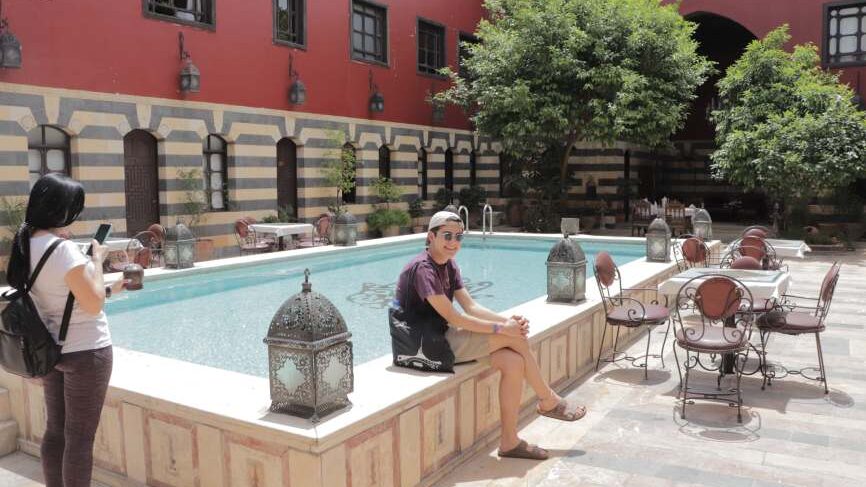
The Talisman Hotel, originally built over 300 years ago as a Jewish palace, is a remarkable example of traditional Damascene architecture. Located in the heart of Old Damascus, this historic house has been carefully restored and turned into a hotel, preserving its rich heritage and unique features. The house is known for its striking burgundy color, which runs throughout its walls, adding to its distinctive character. One of the standout features of the Talisman House is its swimming pool, which holds the distinction of being the only pool in ancient Damascus. This blend of traditional architecture with modern touches, like the pool, makes it a rare gem in the city. Over the years, the house-turned-hotel has hosted several famous personalities, including Queen Sofia of Spain, Queen Noor of Jordan, Angelina Jolie, Brad Pitt, and Francis Ford Coppola. Today, the Talisman House serves as both a living museum of Damascene heritage and a hotel that offers a glimpse into the grandeur of the past.
Beit Jabri – A Historic Damascene House
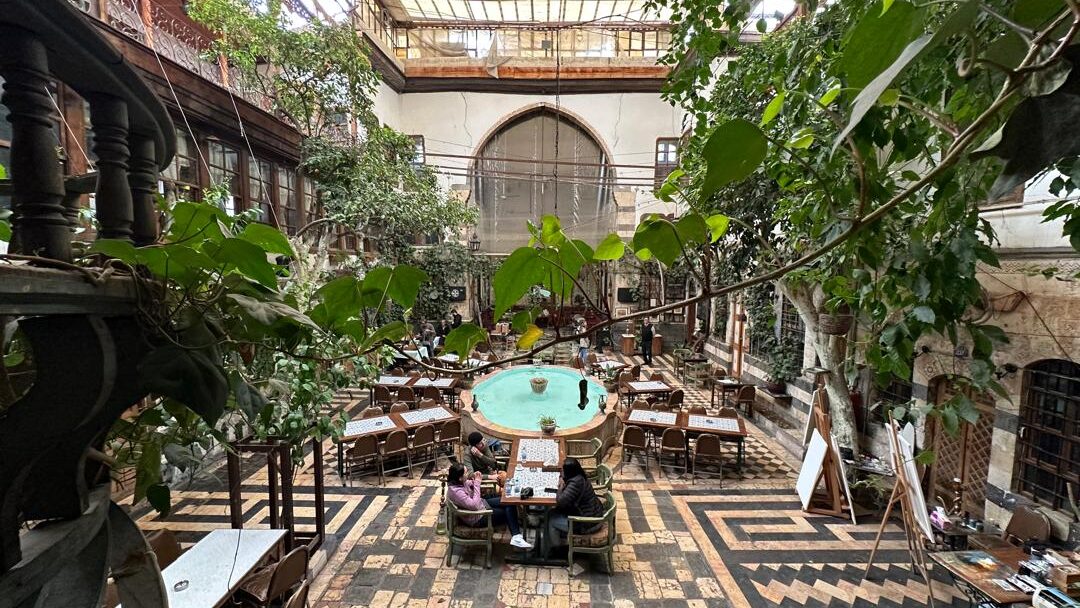
Beit Jabri, built in 1737, is one of the oldest and most historically significant houses in Damascus. Located in the Old City, the house is notable for its traditional Damascene architecture, with walls adorned in mosaic tiles in the Eastern style, making it a prime example of the region’s historical design. The Jabri family lived here until 1977, after which the house was abandoned and began to deteriorate. The house remained in disrepair until the grandson of the Jabri family, Raed Jabri, decided to restore it. To fund the restoration, he converted the building into a restaurant. Beit Jabri covers 1,200 square meters, with around 23 rooms. One of the main features of the house is the central hall, which is elevated half a meter above the ground and surrounded by a courtyard with a small fountain in the center. The walls of the hall are decorated with aplaq, a traditional form of stone carving with geometric patterns, a characteristic feature of Damascene houses. Although renovated and turned into a restaurant, Beit Jabri has maintained its original architectural style and cultural significance. The house is still a fine example of a traditional Damascene house, with its unique layout and traditional features. Beit Jabri has become well-known among locals and tourists alike and is also a location for cultural events, such as art exhibitions, poetry readings, and cultural seminars. Additionally, the house has been used as a filming location for several popular Syrian TV dramas.
Azm Palace: A Historic Example of Ottoman-Era Damascus Architecture
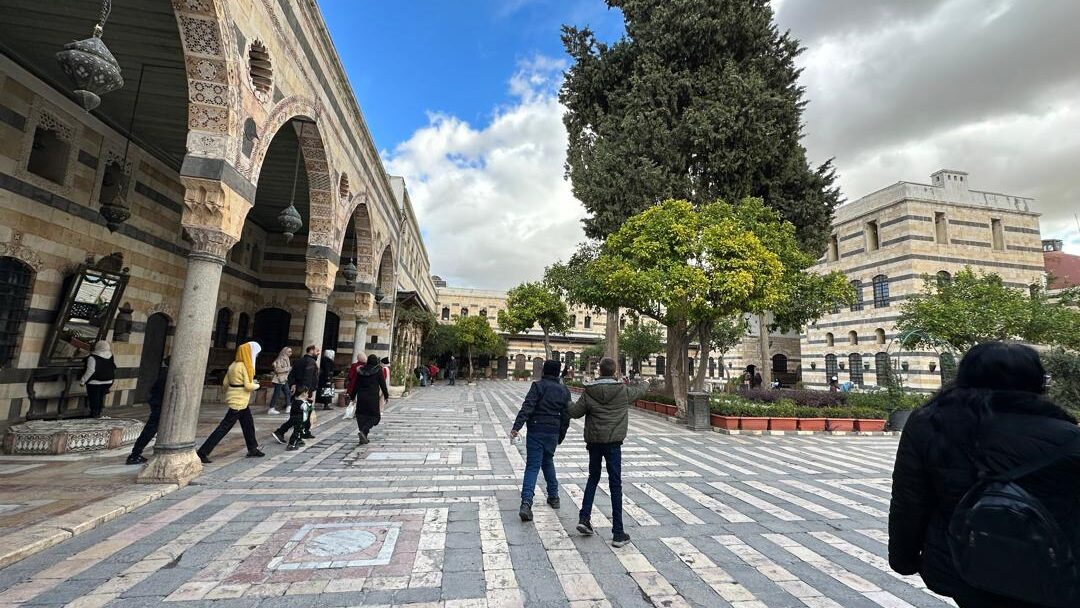
Azm Palace, built in 1749 by Asaad Pasha al-Azm, is a magnificent example of Ottoman architecture in Damascus, designed to reflect the wealth and power of its owner. Spanning 6,400 square meters, the palace is an architectural masterpiece featuring intricate Islamic designs with exquisite use of stone, marble, and wood. The layout includes a central family wing, a guest wing, and a northern section used for managing the household, all set around serene courtyards. The palace’s architecture boasts ornate stone carvings, intricate mosaics, and beautiful woodwork, demonstrating the luxury and sophistication of the time. Azm Palace has a rich history, once serving as the residence of the French High Commissioner during the French Mandate in Syria and later suffering damage during the 1925 Syrian Revolt. After restoration in 1954, the palace was converted into a museum, showcasing the cultural and historical heritage of Syria, with exhibits on traditional life and folklore. Today, it remains a top destination for visitors, offering a glimpse into the splendor of Ottoman-era Damascus and standing as a symbol of the city’s architectural legacy.
Maktab Anbar: A Historical Building in Old Damascus
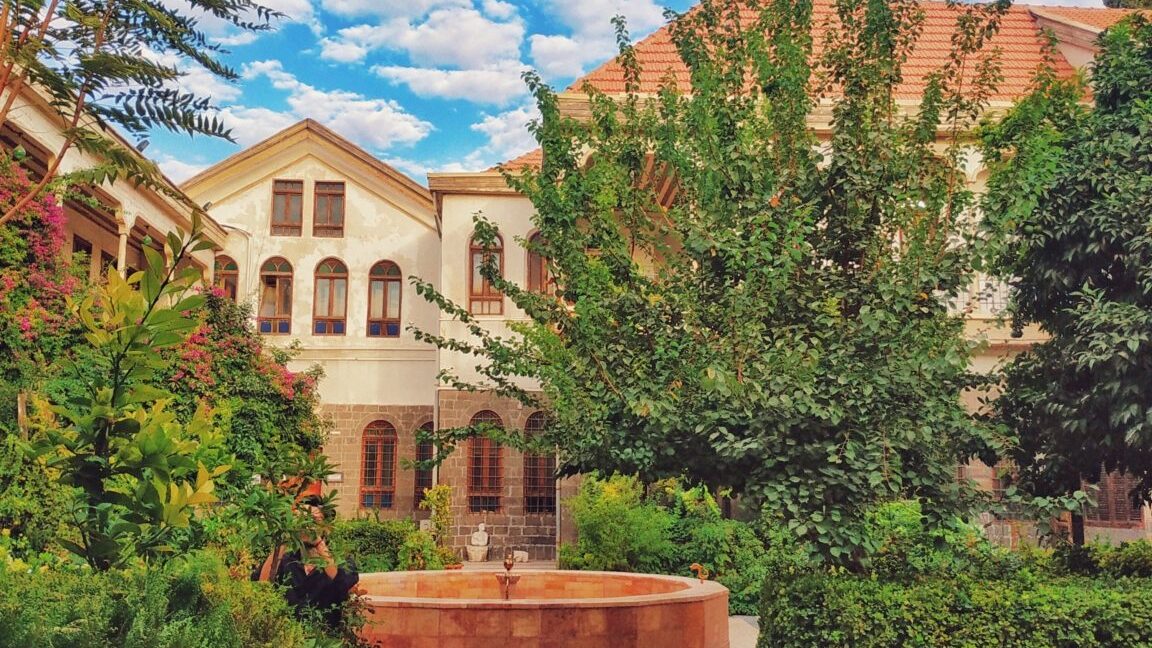
Located in the heart of Old Damascus, near the Umayyad Mosque and Straight Street, Maktab Anbar is a significant historical building. Built in the mid-19th century by Yusuf Afandi Anbar, a wealthy Jewish merchant, it was originally a large residential house. The building covers 5000 square meters and is designed in the traditional Damascus house style, with three main sections surrounding private courtyards and a total of 40 rooms. In the late 19th century, after the Ottoman Empire took control of the property due to a financial dispute with Anbar, the house was transformed into a school, known as a Maktab, to educate boys. The building played an important role in the education of many young people in Damascus, offering subjects like religion and science. During the 20th century, after the fall of the Ottoman Empire and the end of the French mandate, Maktab Anbar continued to serve as an educational institution, later becoming a school for girls. It was a symbol of change during a time of shifting cultural and educational values in Syria. In the 1970s, efforts were made to restore the building and preserve its structure. Today, Maktab Anbar is home to a museum, a library, and craft workshops, and serves as the headquarters for the Damascus Old City Protection Committee. The building remains an important cultural landmark, reflecting the history and development of Damascus.
Mustafa Ali Gallery: A Place for Reflection and Art

Located in the Jewish Quarter of Old Damascus, the Mustafa Ali Gallery is housed in a 300-year-old Jewish house. Unlike many old homes in Damascus that have been turned into hotels or cafes, artist Mustafa Ali transformed his residence into a space to showcase his art. Mustafa Ali, born in 1956 in Latakia, is a renowned Syrian sculptor with international exhibitions. His gallery features 35 sketches that depict faces marked by war, showing expressions of fear, uncertainty, and resilience. These works reflect the emotional and psychological toll of conflict, highlighting both suffering and the hope for resistance. The gallery is not just a space for art; it’s a personal statement by Ali. He restored the house in a way that blends the traditional Damascene architecture with his own artistic vision. The faces in his sketches seem to express the struggles of people caught in a difficult world, yet there is a sense of strength and defiance in them. The Mustafa Ali Gallery is a place where visitors can reflect on the human cost of conflict and the role of art in expressing those emotions. It offers a simple, yet powerful look at the impact of war and the enduring spirit of those who suffer through it.
Nizar Qabbani’s House: A Quiet Memory of Poetry and Damascus
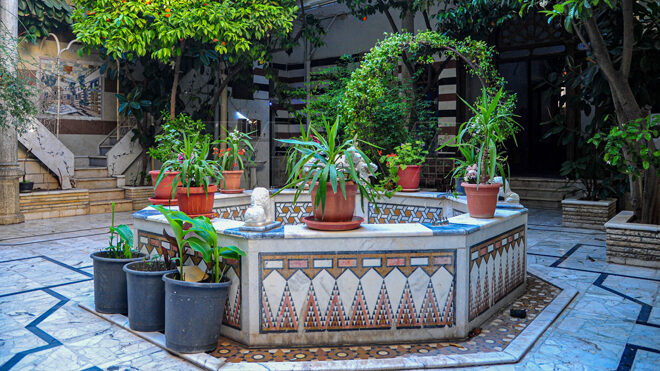
In the Minaret al-Sham neighborhood of Old Damascus stands the house where poet Nizar Qabbani was born and raised. A small sign on the wall reads, “Here lived Nizar Qabbani,” inviting curious visitors to enter. Today, the home is owned by another family who bought it in 1968. The family welcomes guests warmly, offering free access to anyone who wants to explore. This traditional Damascene house, around 250 years old, has 10 rooms across two floors and a large courtyard with a fountain surrounded by jasmine, citrus trees, and old stone walls. Nothing has changed in its architecture — just as Qabbani would have remembered it during his frequent visits, even after becoming a diplomat and famous poet. The home carries stories of his childhood, his love for cats, and his deep connection to the place. It’s also where his father once hosted meetings of the National Bloc, marking the home’s place in Syria’s political as well as literary history. Qabbani once wrote: “Do you know what it means to live inside a perfume bottle? That was our house.” His poetry and memories reveal how this house shaped his romantic, emotional voice. Today, it’s not a museum or a business. The owners refused to turn it into a café or shop. It remains open, simply and quietly, for those who love poetry, heritage, and Damascus.
Beit Al Mamlouka: A Stay in History in the Heart of Old Damascus
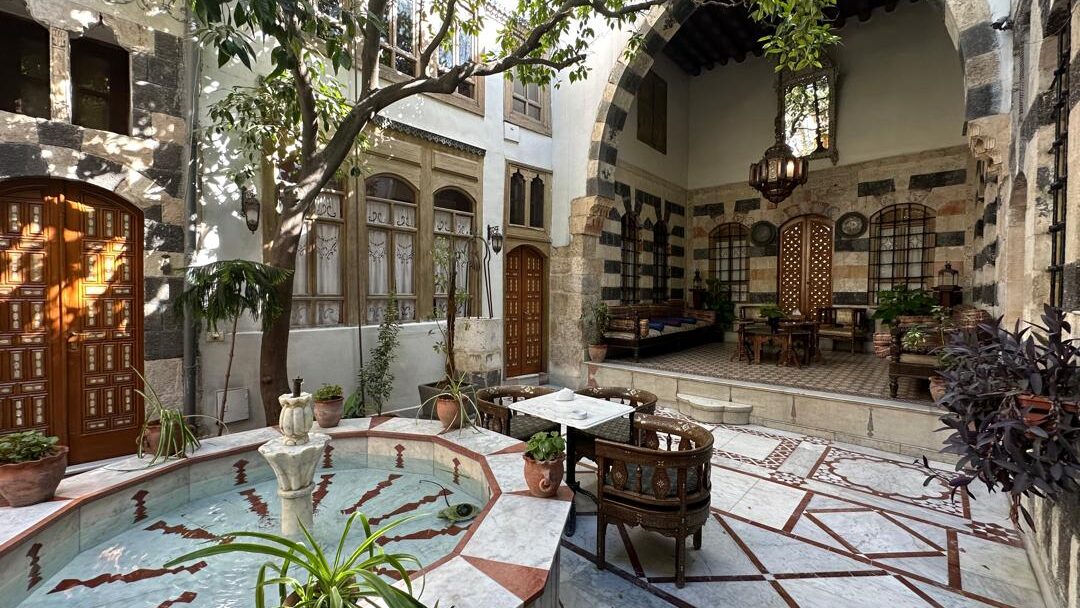
Beit Al Mamlouka is a boutique hotel tucked away in the Bab Touma neighborhood, the old Christian quarter of Old Damascus. Opened in 2005, this charming place is more than just a hotel — it’s a restored 17th-century Damascene house that blends luxury with centuries of heritage. The hotel offers eight unique rooms, each named after a famous figure from Arab or Islamic history, like Ibn Rushd or Baybars. Inside, you’ll find original artwork and antique pieces, including an 18th-century mural, a 16th-century arched corridor, and even a 200-year-old Christian fresco — all carefully preserved. Beit Al Mamlouka isn’t just a place to sleep — it’s an experience of Syrian culture and elegance, set in the timeless ambiance of one of Damascus’s oldest neighborhoods.
Qishla Café: A Restored Damascene House in the Old City
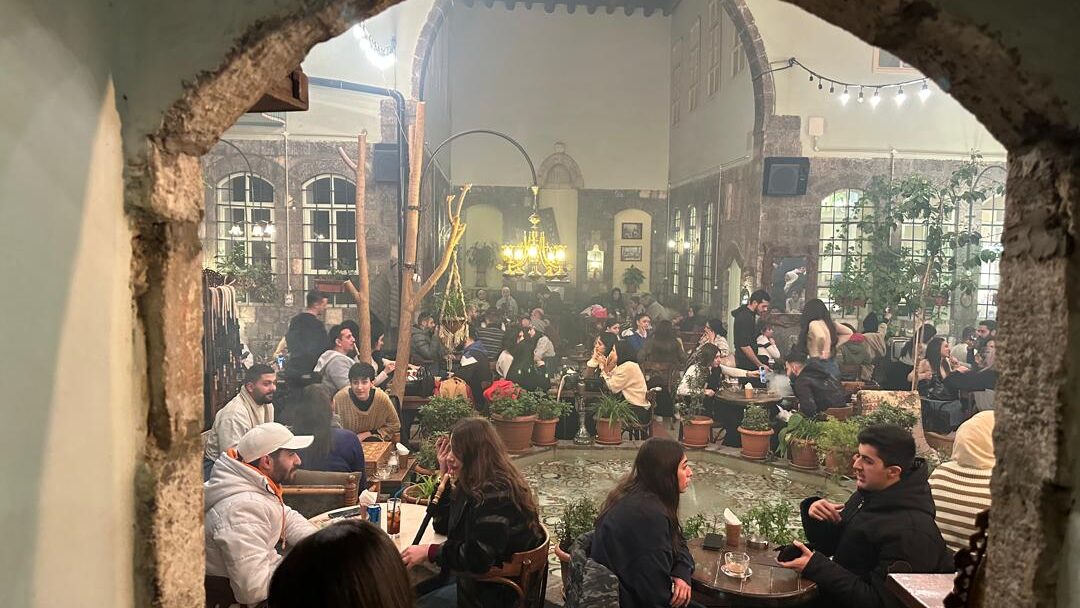
Qishla Café is a cultural and architectural project located in the Jewish Quarter of Old Damascus, housed in a 19th-century Damascene residence that has been carefully restored to reflect its original heritage. The building, which dates back to around 1870, was initially considered for conversion into a heritage hotel. However, following years of conflict and a shift in plans, it was repurposed as a traditional café. The restoration process focused on reviving authentic features of Damascene architecture, such as the liwan (central hall), stone arches, mandaloun windows, and the central courtyard with its water fountain. Original building materials were reused wherever possible, and missing elements were reconstructed based on historical references and architectural plans, including sources like cadastral maps and heritage publications. The space now also serves as a small cultural hub, incorporating an exhibition hall for contemporary Syrian artists and decorative elements that maintain the aesthetic of a classic Damascene home. Today, Qishla Café functions not only as a place for social gathering but also as an example of heritage preservation and adaptive reuse in the urban fabric of Old Damascus.
Beit Al-Wali: A Unique Blend of Tradition and Luxury in Damascus
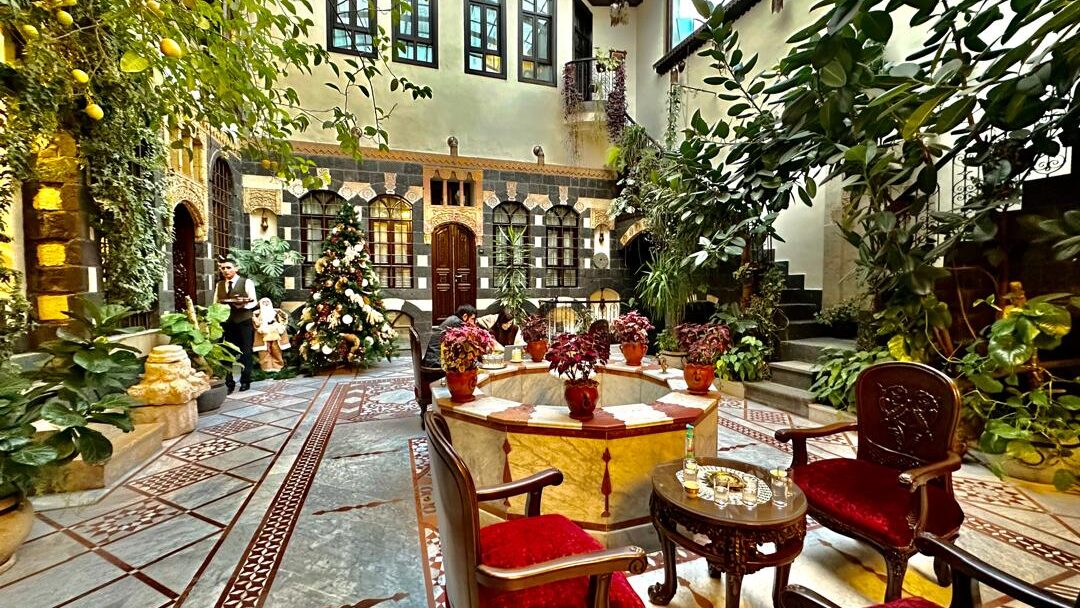
Beit Al-Wali is a five-star hotel in the Old City of Damascus, made up of three connected traditional Damascene houses. These homes date back to the 18th century and were once owned by a well-known figure in the city, which is how the hotel got its name. The houses were carefully restored over four years to keep their original features, like stone carvings and wooden ceilings. The hotel offers 29 rooms, including single, double, and suites, with modern amenities like internet, minibars, and espresso machines. There’s also a restaurant serving local and international food, a business center, and transport services, including airport transfers and tours. Beit Al-Wali is popular with both foreign and local visitors, who enjoy its mix of traditional architecture and modern comforts, along with its central location in the Old City.
